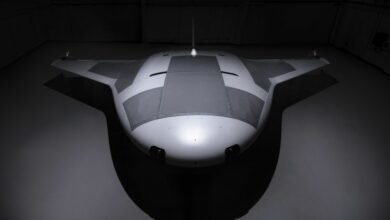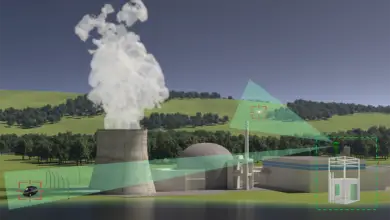
Future battlefields will be filled with technological hazards, including drone swarms, ubiquitous intelligence, surveillance, and reconnaissance sensors (terrestrial- and space-based), hypersonic missiles, and cyber weapons.
The United States needs to be prepared to counter these threats or risk losing the technological edge our military has held in the previous decades.
Although history has generally provided the blueprint for preparing for conflict, one only needs to look to Ukraine to truly understand the nature of some of these emerging asymmetric threats.

Asymmetric Warfare: Example of Drones
For instance, while larger systems like the Turkish Bayraktar TB2 or Iranian-made Shahed-136 unmanned aerial systems (UAS) have made the headlines, commercial off-the-shelf drone technologies have become a strategic enabler and battlefield obstacle.
Ukrainians have demonstrated how to significantly deter and weaken their opponent without increased manpower but through inexpensive, mainly commercial off-the-shelf UAS technology that focuses on intelligence, surveillance, and reconnaissance strength and capability.
Commercial drones can cost less than $400, making them easy to purchase, assemble, and adapt for the battlefield with minimal investment, especially compared to the expensive armor systems they are helping to locate and destroy.
For example, low-cost Ukrainian-acquired drones have knocked out Russian tanks and artillery systems that cost vastly more, usually in the tens of thousands to millions of dollars per system or munition.
Now we see Russian forces mimicking these tactics, which has prompted the Ukrainians to evolve to alternative techniques to defend against the threat posed by drones.
This isn’t the first we’ve seen these asymmetric warfare insertions of drones. Cheap hobbyist drones have been used to conduct intelligence, surveillance, and reconnaissance missions and drop bombs on US and partner forces in the Middle East, including those operating in Syria, which mirror attacks that terrorist organizations like ISIS have already performed.
View this post on Instagram
Developing Layered Defense Strategy
Ukraine has been fighting a drone war since Russia’s invasion in February. As such, they are (re)writing the blueprint on how to defend against drone attacks.
The Ukrainian defenders rely on a combination of continuous aircraft patrols, ground-based anti-air missiles, and small-unit level groups of soldiers utilizing machine-gun fire to try down these drones. According to Ukrainian sources, this strategy has destroyed nearly 237 Iranian kamikaze drones since September.
While examining these threats, the US must continue developing a layered defense strategy in tandem with new and emerging technologies. Much of America’s current counter-drone strategy relies on electronic jammers, expensive surface-to-air missile systems and interceptors, or ballistic solutions such as machine gun fire.
Additional capabilities, such as continuous wave lasers or high-power microwave-directed energy solutions, will be fielded soon.
While continuous wave has been used to defend against threats like mortars and rockets, it requires a long dwell time on a target before its thermal effects destroy the target. High-power microwave weapons require relatively close proximity to the target before they become effective.
There are benefits to using both technologies, and they should and will be a part of any layered defense strategy to counter the threat posed by drones. However, other technologies are being developed that could also reduce or close any potential gaps in coverage, especially when envisioning a swarm of commercial drones.
To fully develop our layered defense against drones and other threats, we need to accelerate our acquisition process and invest in developing new technologies. Ultrashort pulse lasers, for instance, could play a key role in any layered defense.
Now is the time to accelerate the development and acquisition of emerging technologies like ultrashort pulse lasers before we start losing lives and assets to these drone-based threats.

Innovative Future
We should look across the Pacific Ocean while considering future flashpoints.
Tensions between Taiwan and China have escalated recently, even going so far as Taiwanese forces firing warning shots at drones originating from China. This example further highlights the need for a layered defense system to protect the airspace and maritime security of the US and our allies and partners.
Deployment of counter-UAS technologies could prevent the incursion of civilian-operated or national-security managed drones.
Fortunately, our nation is uniquely positioned as a bastion of innovation that can be used to counter drones used by state and non-state actors alike.
While some technological advancements occur incrementally, many more lethal innovations can evolve exponentially with each passing year. We didn’t always have stealth technology, smart bombs, or GPS-based navigation systems, but now we can’t picture fighting a war without them.
We must now look to the technology that will safeguard our service members during the next fight. Laser systems that have yet to be field tested may very well be the next game-changing technology, especially when it comes to protecting against drones.
That “aha moment” will come when emerging technologies are given their fair chance to be proven not just in the laboratory or at the test range but in actual contemporary operating environments.
 Dr. Gregory Quarles (@DrGregQuarles) was hired as the CEO and Board member for Applied Energetics, Inc. in May 2019. He had previously served on the AE Scientific Advisory Board. Prior to joining Applied Energetics, Dr. Quarles served as the Chief Scientific Officer for The Optical Society (now Optica).
Dr. Gregory Quarles (@DrGregQuarles) was hired as the CEO and Board member for Applied Energetics, Inc. in May 2019. He had previously served on the AE Scientific Advisory Board. Prior to joining Applied Energetics, Dr. Quarles served as the Chief Scientific Officer for The Optical Society (now Optica).
He is a globally recognized leader for his strategic partnerships with the Department of Defense and the US Congress, and his innovative work in the progression of global materials research, specifically developing new laser devices for medical, defense, and industrial applications.
He has been awarded five patents related to his research in solid-state lasers, has eight pending, and has published over 120 peer-reviewed and conference publications.
Dr. Quarles is a graduate of Oklahoma State University and holds a Ph.D. and MS in Physics, and a dual BS in Math and Physics.
Disclaimer: The views and opinions expressed here are those of the author and do not necessarily reflect the editorial position of The Defense Post.
The Defense Post aims to publish a wide range of high-quality opinion and analysis from a diverse array of people – do you want to send us yours? Click here to submit an op-ed.










